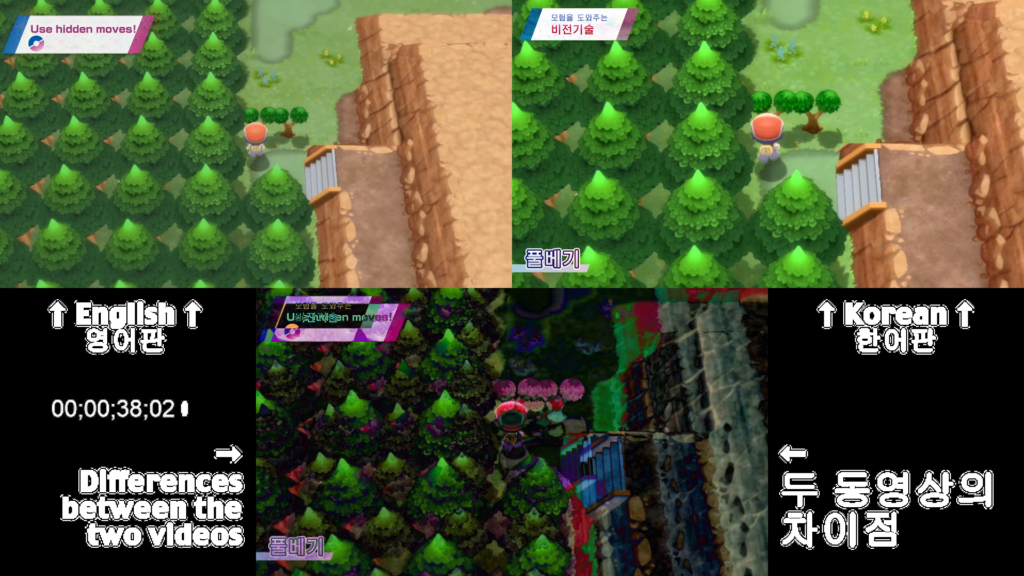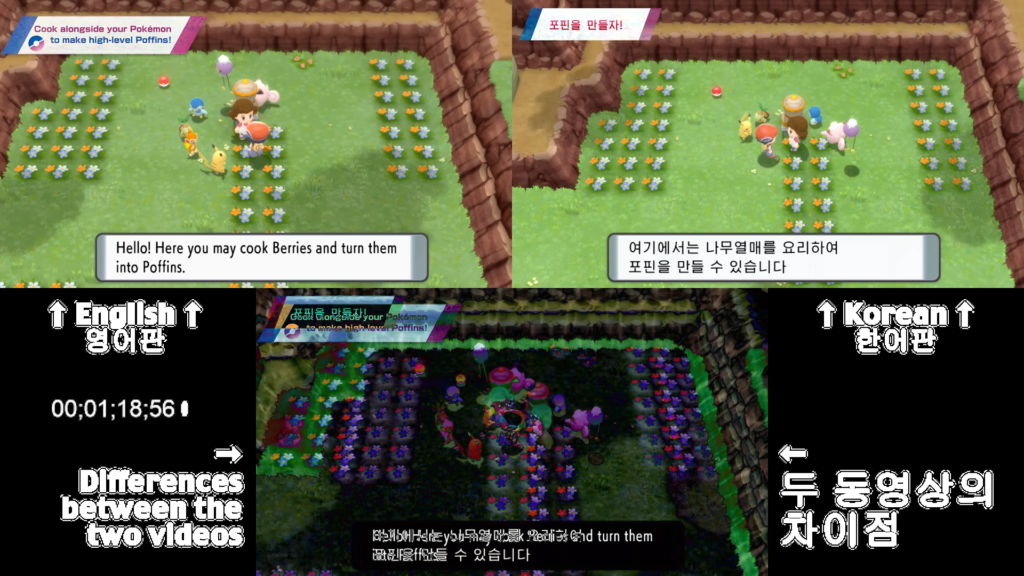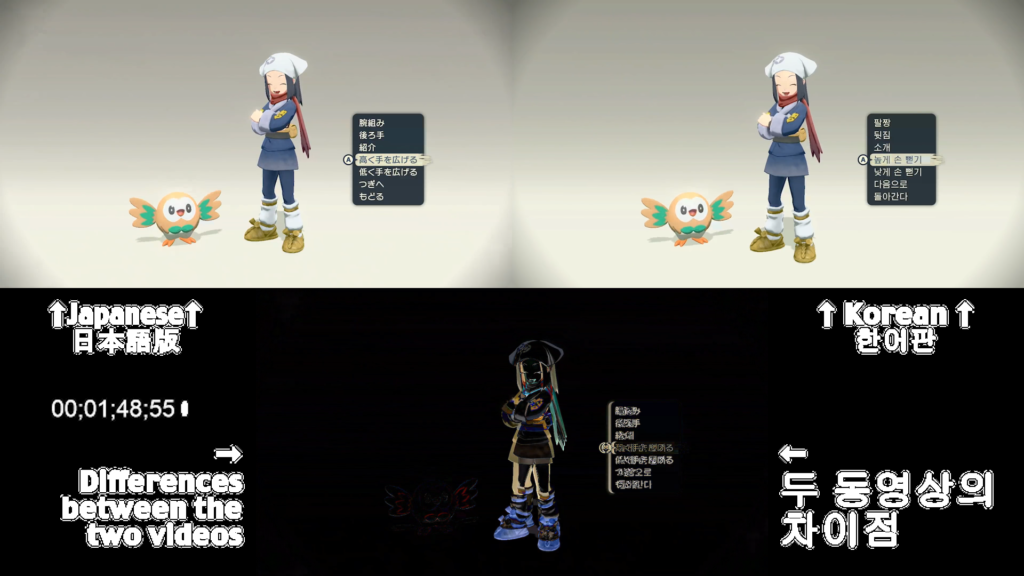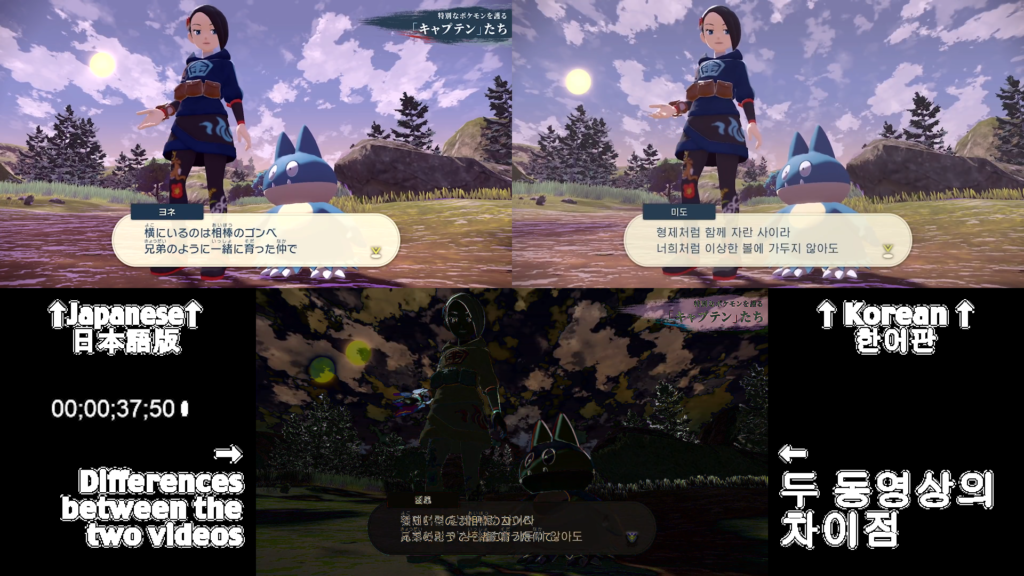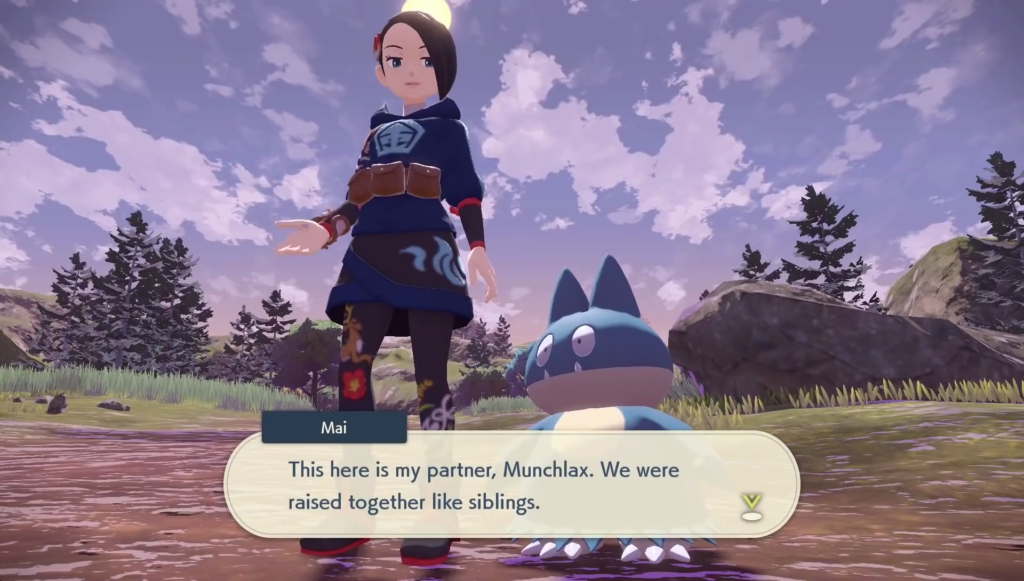The Actual News:

OK! So, now that I’m back to being able to work on regular news articles, let’s talk about some of the new stuff I missed in the last couple months. Namely: new videos about Pokémon Legends Arceus and Pokémon Brilliant Diamond/Sparkling Pearl. Oh crap, BDSP is coming out this weekend! What good timing!
So to cut a long story short, during the last Pokémon Presents (August 18th, 2021), I did a comparison between the English and Korean versions when I had noticed something some minor differences between the two versions. What I ultimately stumbled upon was some interesting differences between the English and Korean versions which reflected different prerelease builds of the game! Stuff like different camera poses, lighting effects, resized rooms… nothing major, but it did give some interesting insight into how games are developed. After releasing that post, I was then made aware of the fact that the Spanish-language (Latin American?) version of the Pokémon Presents videos ALSO had some unique differences, so maybe I’ll go back and cover that as well.
That said, in the time since I did that post and today, there were a few new videos released in English and Korean (and Japanese!) which also show some minor differences. Because it’s late and I need to get up in the morning, I’ll just share them right away. Take a look! …
OH, wait, I do need to point two small things out:
- the comparison video format is the same as the one I made for the Pokémon Presents video, meaning that the English (or Japanese) version of the video is placed on the left, while the Korean version is placed on the right. Furthermore, on the bottom is a sort of “mix” of the two, but rather, it shows the DIFFERENCES between the two. Specifically, if a region of the difference is black or otherwise dark, that means there is effectively zero difference between the versions… but if they’re bright or white, that means there is a massive difference between the two. The color differences is harder to explain quickly, so just focus on the brightness intensity to represent greater differences.
- the English and Korean versions are just SLIGHTLY different, in that their pacing is slightly different. Like, the English version spends more time on one scene than the Korean version, or vice versa. So if there are blank gaps in either the English or Korean sides, just know that I cut and moved that part of the respective video just so it remains aligned later on.
This first version is based on the video released on September 28th titled (in English) “Get the freshest news about Pokémon Brilliant Diamond and Pokémon Shining Pearl!”:
Next is the video released on October 26th titled (in English) “Team Galactic awaits in Pokémon Brilliant Diamond and Pokémon Shining Pearl!”
Although there’s not much that’s actually different, there are still some interesting stuff in these videos! One thing is the depiction of the “Cut” move in both versions; the English version simply does a Cut, while the Korean version says something like “this looks like it can be cut!”, then it zooms in and then does the Cut. I wonder what’ll end up in the final game, because the English seems to be a more streamlined version of Cut while the Korean seems more authentic to the original version.
Another significant difference I spotted was the Poffins scene where your Pokémon are gathered around you and the Poffin Lady, but the scene is slightly different, and Chimchar seems to have disappeared in the Korean version… meeehhh…
While there really wasn’t all that much different between the two versions, they do reveal an interesting thing about how these videos are actually made. But, let’s talk about that later… I want to share the Pokémon Legends Arceus video comparison next!
Now here’s the interesting bit: the Korean version of the PLA video is NOT the same one as the English version! Not exactly, that is. It covers the same topics but its arranged completely differently. I then thought maybe I could just compare the English with the Japanese version, but it turns out the Japanese and Korean versions are similar, with the English version being the odd one out. Weird! Well, here’s the comparison of the Japanese and Korean versions of the video that would be titled (in English) “Encounter Noble Pokémon in Pokémon Legends – Arceus!”, also released on September 28th.
I do plan on maybe taking the English version and cutting in similar scenes from the Korean version, but we’ll see. Another thing to note is that the English and Korean Pokémon YouTube channels have other videos about BDSP, but noe of them seem to be the same videos as the other, so I can’t match them up. Should their other respective versions be released, then I’ll cover them.
But that said, like with the BDSP videos, there really isn’t all that much that’s significantly different between the two versions. I did spot ONE difference: it’s when Akari is posing for her photo… looks like the Korean version’s model was a ever-so-slightly larger in size relative to the Japanese version… or maybe she’s just positioned slightly closer to the camera? Take a look, and look at her feet relative to Rowlet:
Otherwise, apart from any point where there is Korean or Japanese text (and that one difference above), the two videos are essentially exactly the same! …OK, well, apart from the special TCG promo that’s only available with the Japanese version. Kinda struck out today, didn’t I?
Well, not quite! I did say that these videos sorta inadvertantly gives us a peek into how they’re made, and actually how the devs deserves a bit of credit for making sure their game remains unified in look and feel across multiple languages! Let me explain.
So, as you might have noticed, some scenes between English, Japanese and Korean are literally the same (represented by a pitch black scene in the “Differences” view on the bottom). Here’s a perfect example:
It’s only when the two games show footage of different languages that things start to look a bit different… such as in every single screenshot from above. Based on this, it seems pretty obvious to me what’s going on:
Clearly Game Freak/Nintendo has their video staff, but it’s not a single staff. Rather, it’s staff located around the world… Japan, Korea, the US, Europe… and GF/Nintendo is providing their staff all the necessary footage AND script of sorts for them to follow. If it’s not literally the same Adobe Premiere project file, then it’s at least a timeline of when everything is supposed to appear and in what order. Then there’s stuff like the US and UK versions… if the US video staff isn’t simply just manually adding in “U”s to words like “color” and “flavor”, then it’s some bloke in the UK downloading the US video files and doing it manually themselves. But just that’d be too much unnecessary work; it doesn’t take some one in the UK to just throw in a few “U”‘s… some intern could do that!.
So what about the video files? Well the video crew is also relying on GF/Nintendo to provide those as well. In that case, it’s obvious to me that they’re producing two sets of videos:
- the videos without any IRL language in it are universally used in every single video world wide… not only is rerendering the same video more than once pointless, it also helps maintain brand unity and cohesion across all the different language versions of the same game
- the videos WITH an IRL language in it are basically recorded once for each language, albeit effectively in-game, one by one.
- That is to say, their dev version of the game is able to switch between different languages on the fly… so all they do is select “Japanese” in-game, record the scene, then select “English” in-game, record the scene, etc etc etc…. this is why maybe it looks like it’s taking place at different times of the day.
A perfect example of the dev’s simply playing the same scene but swapping languages in-game is this scene of Mai in the Japanese and Korean versions: notice the sun has set a bit in the Korean version (or maybe rose in the Japanese version)?
And hey, the English one shows the sun above Mai’s head!
Seeing this, I imagine that, if we wanted to, we might be able to get an idea of what order they record each language in by looking at the scene of Mai in all the different languages and seeing the position of the sun relative to one another. Like, there’s most likely a protocol concerning which languages they record, and some intern in Japan is selecting a language, hitting record, then checking that language off the list… one by one. I imagine that, if the sun is setting, then it might go English, then ???, then Japanese, then Korean, then ???. Maybe I should try to look into this a bit deeper later?
Anyways, once GF/Nintendo has all the videos they need, they simply send them off to their respective video crews. Or, most likely, they just upload it to their own servers and each language team downloads the versions they want. Perhaps they’re stored something like:
- Scene1_Universal.mp4 (this is a version that is the same across all languages)
- Scene2_EN_v2.mp4 (meanwhile “scene2” is the one in different languages… I’m just taking a guess about the full list here…)
- Scene2_JP_v2.mp4
- Scene2_KO.mp4
- Scene2_FR.mp4
- Scene2_DE.mp4
- Scene2_IT.mp4
- Scene2_ES-LA.mp4
- Scene2_ES-EU.mp4
- Scene2_PO-BR.mp4
- Scene2_PO-EU.mp4
- Scene2_CS.mp4
- Scene2_CT.mp4
- Scene3_Universal.mp4
- Scene4_….etc etc you get the idea
Makes sense, pretty standard… but AHA! What about the significant differences between the different languages? Like the Korean scenes with Akari in a different pose relative to the Japanese or English versions? Or the differences between the Spanish-language versions that I was told about? If they were all done at the same time, then why does it look different? Well, it might be because they WEREN’T done at the same time!
OK, so, let’s be honest: some languages are gonna be seen as more important to Game Freak and Nintendo than others. Certainly English and Japanese would be, especially relative to Spanish and Korean. So I imagine that maybe when they started this process, they really DID record the same scene all at the same time. BUT, later on, maybe the devs noticed something was wrong, or something got updated later, or who knows what, and the video needs to be updated. Now, if it was a SERIOUS error, I’d expect that they would have updated EVERY video and then let their respective video crews worldwide know about the updated video file they’d need to re-download. But if it was just a minor error or a tinsy update… then most likely they would have only bothered to update the English and Japanese versions. Especially if different video teams are working at different paces but also all have the same deadline for release… maybe the English and Japanese teams were able to get the updated video in but the Spanish and Korean teams could not. With so many different moving parts, things aren’t always going to mesh up… but as long as MOST of it does, that’s all that matters in the end.
The side effect of all these different teams getting and using different video captures of a certain game element recorded at different times during its development is that it can accidentally reveal certain prerelease details which would have otherwise been locked away in Nintendo’s vaults, never to be seen (until a Gigahacks-tier hack leaks them out to us). Like, if the Korean version of the Direct’s BDSP trailer didn’t accidentally use old footage, we would have never known that the devs had changed the floor dimensions from 14×10 to 12×8, among other things. Nifty!
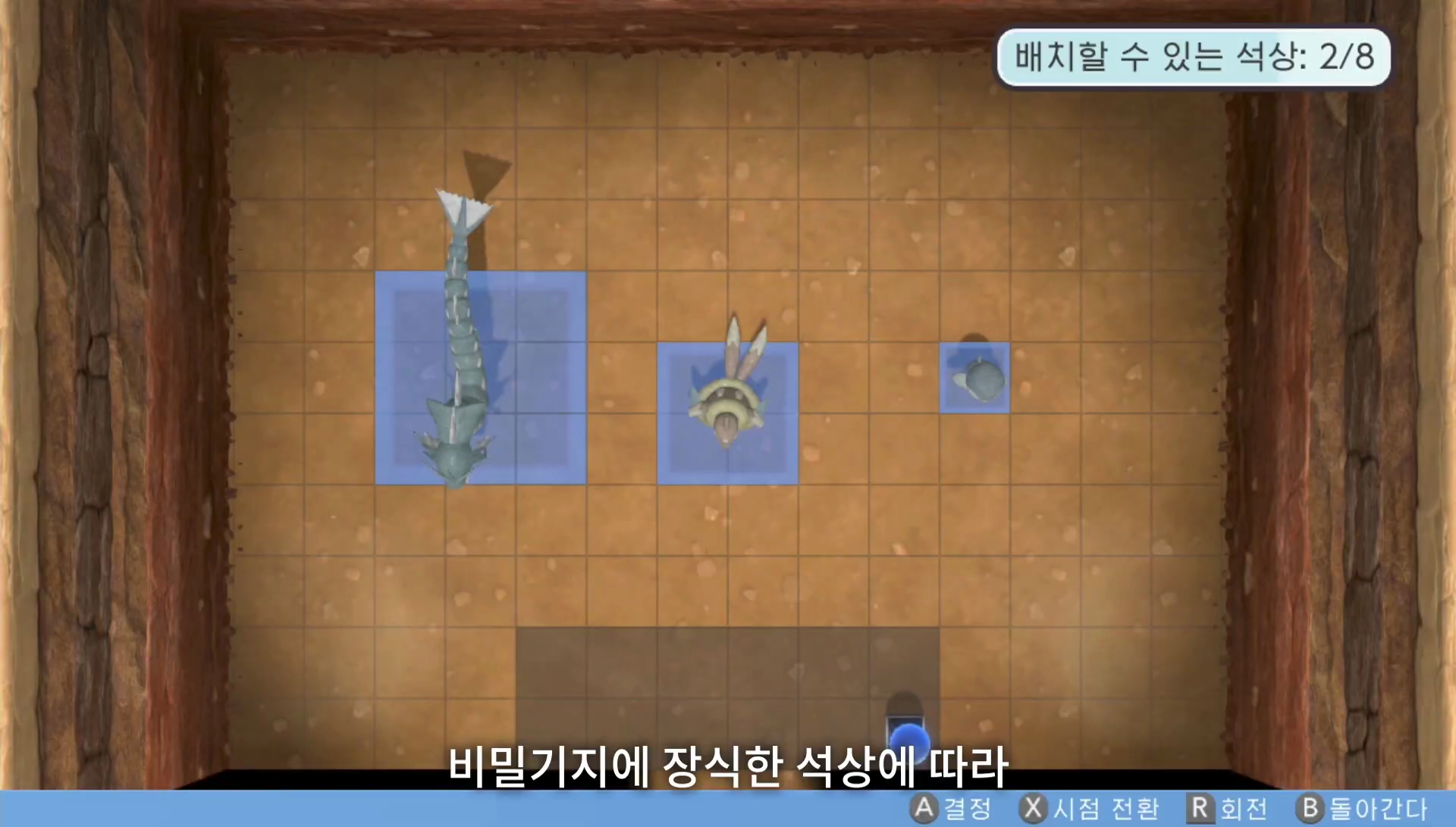
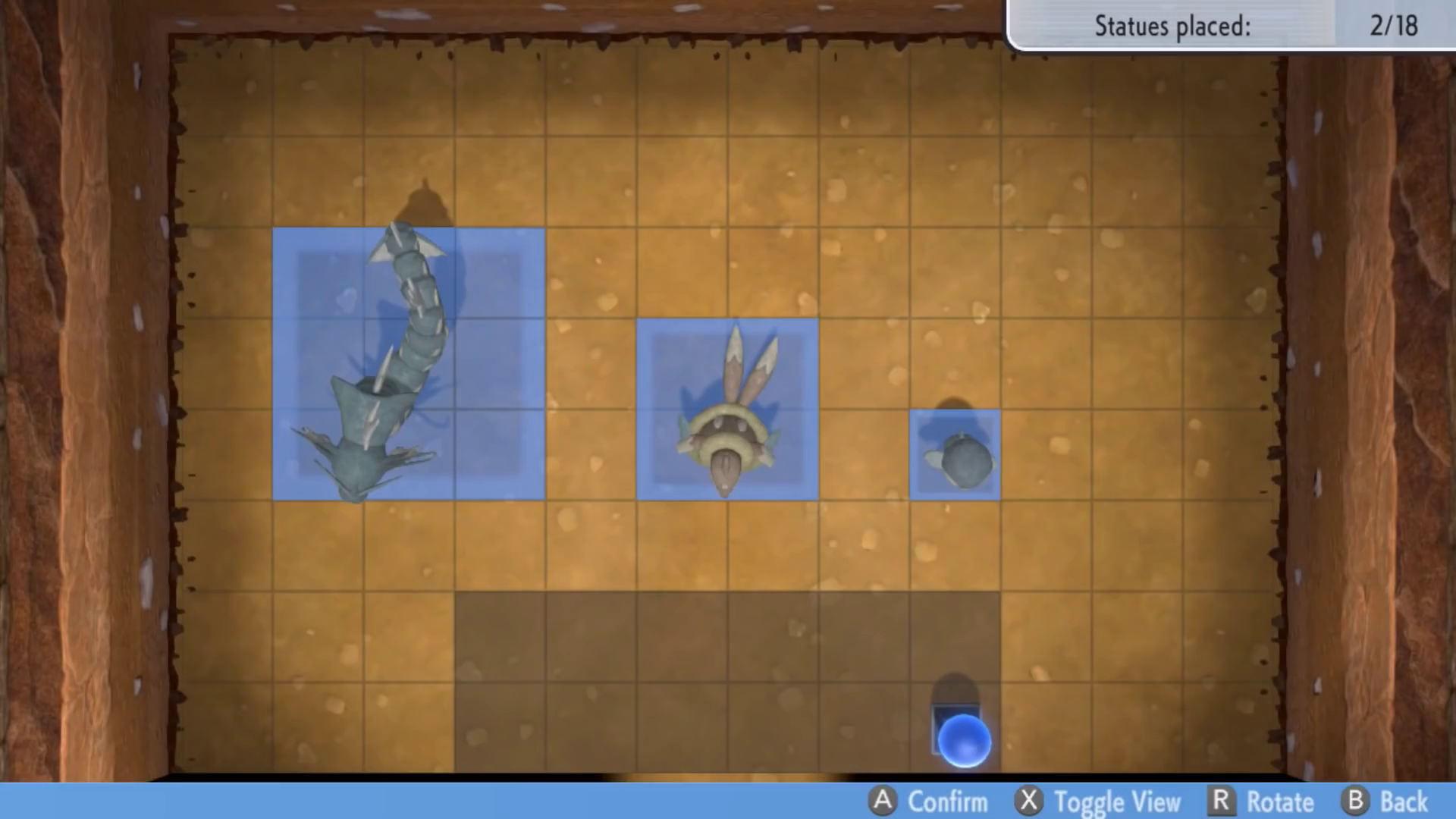
In any case, ultimately this is all speculation on my part… but it is a strongly educated guess based on my own experiences working with/for other companies in video, document design, etc, where updates are commonly sent out to workers, deadlines need to be met by different teams, etc. In that case, I’d say that I’m fairly confident that I’m right on the money about a lot of this… and therefore I hope it gives you some interesting insight as to how these videos are made and perhaps why these little “errors” crop up from time to time. Frankly, I’m impressed with Game Freak, Nintendo, TPCi, etc, in being able to keep this well oiled machine in operation… the idea of having one unique language video for each of the languages in your game… to say nothing about having that many different scripts in the game… I think this is way more important to maintaining the quality of the brand than people getting upset at Giratiny…
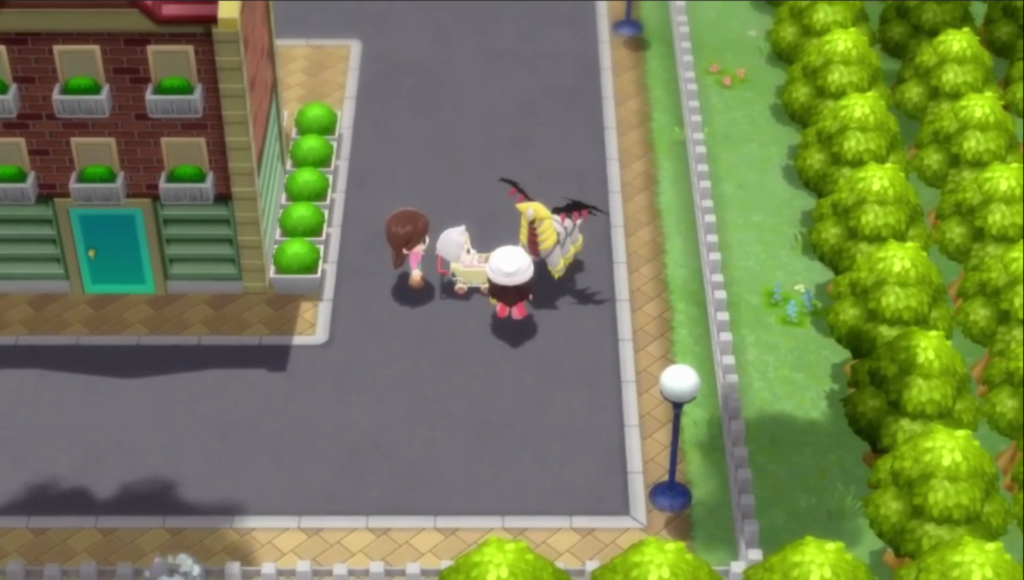
…don’t worry, I’ve got a post coming in due time about people being pissed off about the ways Pokémon has ALWAYS been.
But anyways, that’s all I got for today! I know, pretty short post, but I’m working my way up to the big stuff. Like, just today I rediscovered my copy of Dec 1998 issue of Duelest Magazine where it talks about some crazy Japanese Monster Phenomenon that’s planning it’s North American invasion soon. I’m planning to roll THAT bit of history into an article about some really old but nifty print articles about Pokémon and seeing how well (or not) they’ve aged. Keep an eye out for that soon. Until then, good times…!

